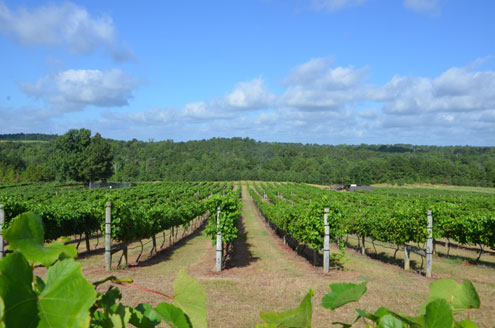COLLEGE STATION – According to Texas A&M AgriLife Extension Service experts, vineyard owners and wineries in Texas have reason to be in good spirits this spring — in spite of some challenges in the form of severe weather in grape-growing areas of the state.
“There has been almost no rain since October, but vines are growing well under irrigation. Bloom stage will be here in three or four more weeks,” said Dr. Pierre Helwi, AgriLife Extension viticulture specialist, Lubbock.
Helwi said producers in the region have been fortunate so far in avoiding hail damage.
“We have had good bud break and are seeing some small inflorescences, which is what we call clusters at this early stage of development, here in the West Texas High Plains,” Helwi said. “And there have also been no significant losses from four recent freezes we have experienced, as the vineyard owners have been able to employ various techniques to keep the vines from freezing.”

Fran Pontasch, viticulture program specialist in College Station, who covers the Gulf Coast area, said vineyards there are doing “surprisingly well” in the aftermath of Hurricane Harvey.
“Growers and their grapevines are especially resilient and grape production this year is very promising,” Pontasch said. “Fortunately, the grapes had already been harvested when Harvey hit, so there was no direct impact to last year’s crop. But the winds and flooding did some structural damage in some vineyards, such as knocking over trellises or causing support posts to sink. However, pretty much all of this damage has been repaired, and the producers are back to business as usual.”
She also noted equipment lost due to the flooding has been replaced and is fully operational.
“A main cause of concern after Harvey was the potential for plant disease resulting from excess rainfall,” she said. “That can lead to root rot and downy mildew, but we did what we could to help prepare by letting producers know about the proper type and use of fungicides to combat these diseases. Fortunately, neither became an actual problem and there was no more disease found than in a typical wet year.”
Pontasch said one of the long-term post-Harvey effects is that many producers are taking additional precautions against flooding and are adding additional drainage in and around their vineyards.
“They realize a ‘500-year flood event’ is likely to come about much sooner than anyone expected and they need to make sure they prepare for it,” she said.
Brianna Hoge, AgriLife Extension viticulture specialist based in Fredericksburg, said the vineyard and winery business in the Hill Country continues to grow at a rapid pace and the quality of grapes used for wine production has “skyrocketed” in recent years.
“Hill Country wineries are really focused on producing high-quality grapes for the making of high-quality wines,” she said. “And this year’s grape crop is looking excellent so far.”
Jim Kamas, AgriLife Extension fruit specialist in Fredericksburg, said even though the area has received some rain, it is still necessary for many producers to supply drip or other irrigation in their vineyards.
“While we could use some more rain, the irrigation has made up for that so far and vines are looking healthy and beautiful,” Kamas said. “We’re already at or close to budding in most vineyards, and things are looking very good for both grape production quality and quantity.”
Kamas also noted the dry winter and spring have helped reduce pressure on grapes from root rot, downy mildew, Pierce’s disease and other common plant diseases.
Michael Cook, viticulture program specialist in Denton, said expectations are high for another good wine grape crop in that region this year, though probably not as exceptional as last year.
“Last year we had mild weather and great growing conditions for wine grapes, so the quality and quantity were both outstanding,” Cook said. “However, this year we had two freeze events with cold fronts that blew in toward the end of April, dropping temperatures more than 50 degrees in less than 24 hours. Those freezes damaged crops from the Red River down to Stephenville, including vineyards around Denison, Gainesville, Muenster, Decatur and the Stephenville and Dublin area.”
He noted the two freezes primarily affected the early ripening white wine grape cultivars.
“This year, although we had a more normal winter as compared to last year, we have had an ample amount of rain and vineyards in East Texas and the Dallas-Fort Worth area were not detrimentally affected by the freezes. Crops are developing well so far and overall it looks like it will be a good year for grape production in this area.”
Dr. Justin Scheiner, AgriLife Extension viticulture specialist, College Station, said thus far the grape crop looks good from the Gulf Coast down to the Rio Grande Valley.
“Some of the vines in the Rio Grande Valley are already past bloom and others seem to be coming along nicely,” he said. “As is typical, this area didn’t experience any big drops in temperature, so there was no frost damage to the grapes here. It looks like the grape crop in this area is off to a good start as well.”